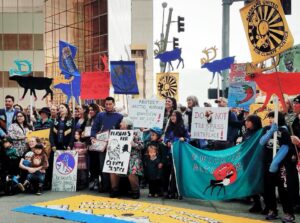
Stand for the Arctic Refuge

Caribou in the Arctic Refuge. Photo by Subhankar Banerjee.
In December, the Trump administration released a rushed draft environmental impact statement aimed at pushing oil and gas drilling in the coastal plain of the Arctic National Wildlife Refuge.
The government shutdown stalled essential services, but not Trump’s drilling agenda. Public and political pressure stopped the administration’s effort to push drilling when government workers went unpaid, but it made clear this administration’s intention to circumvent public process and the law.
Shortly after the shutdown ended, the administration rushed public meetings across Alaska and Washington, D.C., giving the Fairbanks community just four days of notice. Indigenous communities which would be the most impacted were all given less than two weeks of notice for these important meetings.
The administration further hoped to stifle voices in cities by not allowing for public testimony. Fairbanks showed up, however, and asserted its expectation of an inclusive public process. The chance to participate in public hearings has ended, but you can still speak out in writing until March 13.

Anchorage rally for the Arctic, May 2018. Photo courtesy Defend the Sacred Alaska.
Give voice to the Arctic by March 13
What can you say about the draft EIS? For one thing, it fails to evaluate how oil and gas extraction fulfills the purposes outlined for the Arctic Refuge in federal law—purposes that include safeguarding wilderness, wildlife, habitat, and the traditional uses of these lands and animals by indigenous people.
The draft EIS also fails to analyze how oil and gas would affect the way of life of the Gwich’in people, who consider the Coastal Plain to be sacred and have relied on this area for millennia to support their way of life. The draft EIS also ignores important negative impacts on the health of air, water, and animals like caribou, polar bears, and an array of fish, birds and mammals essential to Arctic Refuge health. It also does not accurately evaluate how this special place is already being impacted by climate change, and the ways oil and gas development would make these changes more dramatic.
Find out more about the flaws and holes in the draft EIS, and how you can participate now.
Submit comments via the Alaska Wilderness League, Defenders of Wildlife, or directly through the website, blm.gov/alaska, or by mail to Coastal Plain Oil and Gas Leasing Program EIS, 222 W. Seventh Ave., Stop #13, Anchorage, Alaska 99513.


